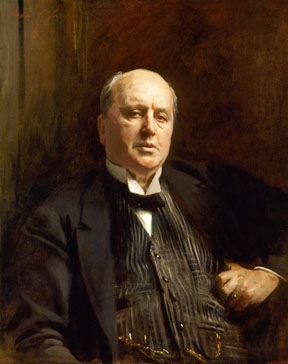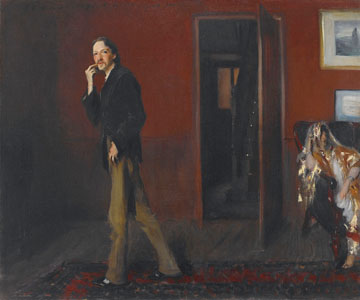Art Review: Sargent: Portraits of Artists and Friends at The Met
By Kathleen Arffmann
ART TIMES Fall 2015
 John Singer Sargent (American, Florence 1856–1925 London) Madame X (Madame Pierre Gautreau), 1883–84 Oil on canvas |
There is so much to learn about John Singer Sargent. The exhibition dedicated to his work, which opened at the Metropolitan on June 30, speaks volumes about his life and work as an artist, so much so that it can be argued that no additional commentary is required, including mine.
Although information provided by the museum on the labels and audio tour is very helpful, there is still one question that remains unanswered: “Why did this accomplished painter leave Paris at the height of his career, and portrait painting altogether when he was riding the crest of his acclaim?” Henry James, the author and one of his closest friends, called Sargent “the slightly uncanny spectacle of a talent which on the very threshold of its career, has nothing more to learn.” His choice to leave Paris makes him something of an enigma and the question left unanswered is troubling for me, and I suspect for other members of the viewing public.
It has been proposed that Sargent left Paris because of the scandal that ensued from his “out of the box” portrait of Madame X, the glamorous bare shouldered lady in black. (This painting belongs to The Met’s permanent collection and can usually be found in the American Wing.) However, there might have been other factors involved in Sargent’s decision to move to England and Madame X was merely the last straw.
Sargent’s skill as an artist was obtained from the reservoir of knowledge of art and painting techniques that had evolved over centuries and was available at the Beaux Arts School in Paris in the late 1800’s. Carolus-Duran was his teacher and Sargent was a devoted pupil who became a convert to his approach to portrait painting and especially of drawing directly on the canvas with a loaded brush. Although there were many artists at that time who shared Sargent’s adherence to the traditions of the past, Zorn and Sorolla to name two, Paris of that day was the center of all things new and innovative in art. Photography was just one of the innovations impacting the art world and portrait painting in particular. Great changes were happening precisely at the time Sargent abandoned the city of Paris. New for new’s sake, the mantra of the art world today, was a philosophy then on the rise. Sargent was engulfed in this cultural milieu, to which his close friends, Monet and Rodin, were integral. Sargent’s work was greatly influenced by Impressionism. One can see by his visible brush strokes, especially in his landscapes, and in the background of some of his portraits that Sargent was comfortable adopting impressionistic techniques. Sargent, however, must have found the more radical trends, which distort the appearance of things, incompatible with his sensibilities.
 John Singer Sargent (American, Florence 1856–1925 London) Henry James, 1913 |
Sargent’s art was grounded in the classical ideals of Beauty and Truth. These were his compass and they guided his process as an artist. Traditional values were just beginning to recede in importance in Paris as the formative thinking of modernity was taking root. Sargent’s fidelity to Truth and Beauty and the technique he acquired to express them are clearly and unapologetically revealed in the works we see in this exhibition. No gimmicks required. Painting after painting arranged chronologically in the exhibition, affirm his goal to instill Beauty and Truth into his work. It would seem, then, that this is why Sargent would be more comfortable in England, a conservative haven with a far greater appreciation for the ideals of the past.
Painting is often problem solving; and it offers many challenges. When you look at Sargent’s sketch of Eleonora Duse, who is considered one of the first modern actors in the history of theatre, you clearly see where Sargent wanted to go in creating a work.
His first objective was the truth of his subject and he managed to capture her essence, in little over an hour, with great directness and few brushstrokes before Duse decided to quit her post. This same directness with his subject is seen in every finished painting. Sargent draws upon great skill in order to reveal the inner life of his subjects in how he portrays their faces and their hands. Everyone has a favorite Sargent painting or paintings. Mine are of authors Henry James and Robert Louis Stevenson and the actor Eleanora Duse.
 John Singer Sargent (American, Florence 1856–1925 London) Robert Louis Stevenson and His Wife, 1885 Oil on canvas |
As I was leaving the exhibit for the second time (I don’t think anyone should see an exhibit like this just once), I ran into an old friend, a painter, and we spoke about Sargent’s brushwork. The way Sargent piled on the paint one could tell he loved its consistency. The paint is thickly applied in most of his pictures and the brushstrokes are very visible. Paint was different in the late 19th century, I’m told. Today, one would have to add a medium to get the paint to flow as loosely as it did for Sargent, who had advised painters to ‘let it flow’. I noticed his use of opaque white, especially on the landscape paintings near the end of the exhibit. The color was used in order to capture the light. Some of his brushstrokes appear to be made by a hand possessed going in all directions; but all with great effect.
At the end of his life Sargent gave up accepting commissioned portraits and painted generally for himself and almost entirely in watercolor. There are some watercolors belonging to the Met included in this exhibition. Many other watercolors, not included in this exhibition, were never intended to be seen. A friend persuaded him to sell his private sketchbooks. These were some of the watercolors featured last summer at the Brooklyn Museum and in the fall at the Boston Museum of Fine Arts. I mention these works because they reveal that despite his seeming rejection of innovative styles in painting, Sargent never gave up painting. He eventually came to terms with doing something new. He continued to paint and explore in his own way choosing watercolor exclusively and varying his subject matter. His late watercolors are more experimental; yet they incorporate his painterly skills, his intense focus on the Truth of his subject and his ability to problem solve in the pursuit of Beauty. In the end, Sargent found a way to be truly himself as well as truly modern.
Each time I visited the exhibition over the summer I met friends, painters, I have known from the National Academy, the Art Students League and Salmagundi Club expanding their knowledge of painting by appreciating the work of this great master.
If you still haven’t seen this landmark exhibition you have only until October 4.
(Richard Ormond CBE has curated the exhibition with advice from H. Barbara Weinberg, the Metropolitan Museum’s Curator Emerita of American Paintings and Sculpture and a Sargent scholar. It is curated in New York by Elizabeth Kornhauser, the Alice Pratt Brown Curator of American Paintings and Sculpture, and Stephanie L. Herdrich, Assistant Research Curator.)
The Metropolitan Museum of Art, 1000 Fifth Ave (at 82nd), NYC (212) 535 7710.
